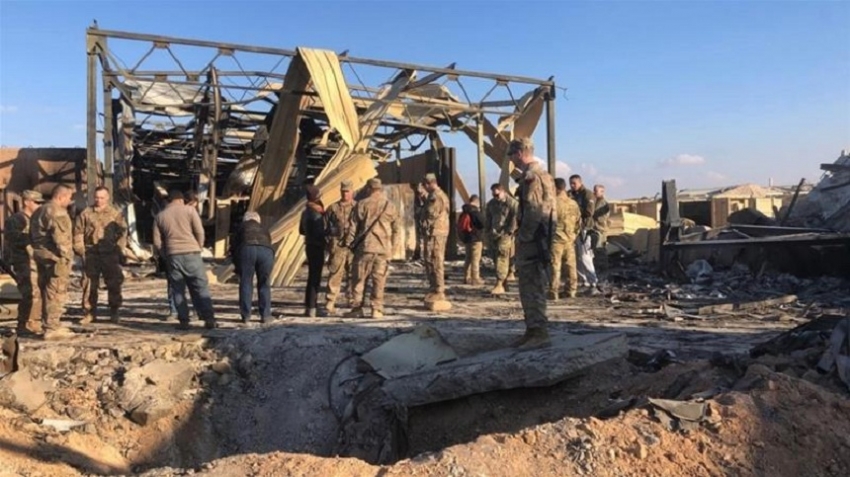Inside the US base attacked by Iranian missiles
The Pentagon has said that 34 US troops were diagnosed with traumatic brain injuries (TBI) following an Iranian attack on their base in Iraq.Seventeen troops are still under medical observation, a spokesman said.President Donald Trump had said no Americans were injured in the 8 January strike, which came in retaliation for the US killing of an Iranian general.Mr Trump had cited the supposed lack of injuries in his decision not to strike back against Iran.But last week, the Pentagon said 11 service members had been treated for concussion symptoms from the attack.Asked about the apparent discrepancy this week at the World Economic Forum in Davos, Switzerland, Mr Trump said: "I heard that they had headaches, and a couple of other things, but I would say, and I can report, it's not very serious.""I don't consider them very serious injuries relative to other injuries I have seen," he said when asked about possible TBIs.The Pentagon says no Americans were killed in the Iranian missile strike on the Ain al-Asad base, with most sheltering in bunkers as missiles rained down.
On Friday, defence department spokesman Jonathan Hoffman told reporters that eight of the affected soldiers have been sent back to the US for further treatment, while another nine are being treated in Germany.Sixteen troops were treated in Iraq and one in Kuwait before all 17 were returned to active duty, officials say.Mr Hoffman added that the US Defence Secretary Mark Esper had not immediately been aware of the injuries in the days after the attack.Iraq & Afghanistan Veterans of America, a non-profit organisation, slammed the Trump administration for taking so long to reveal the extent of casualties."This is a big deal," its founder Paul Rieckhoff tweeted. "The American people must be able to trust the government to share information about our sons and daughters in harms way. Nothing is more serious and sacred."
TBIs are common in warzones, according to the US military.The most common cause of a TBI for deployed soldiers is an explosive blast, writes the US Defense and Veterans Brain Injury Center.They are classified as mild, moderate, severe or penetrating. A mild TBI is also known as a concussion, and can be caused by a blast's "atmospheric over-pressure followed by under-pressure or vacuum".The air vacuum is capable of penetrating solid objects, making it possible for soldiers to avoid blunt force trauma but still receive an invisible brain injury.On Friday, tens of thousands of Iraqis protested in the streets Baghdad against the presence of some 5,000 foreign troops in the country.The Iraqi parliament has urged all foreign fighters - including from the US - to leave.
Iraq after Soleimani: What is the future for US troops?
By Nafiseh Kohnavard
BBC Persian, Union III airbase, Baghdad
24 January 2020
Share this with Facebook Share this with Messenger Share this with Twitter Share this with Email Share
Related TopicsIraq protests
Image copyrightUS ARMY
Image caption
US troops are in Iraq to help in the fight against the Islamic State group
"Incoming, Incoming!" The loudspeaker screeches out a warning of a rocket attack at Union III, the US-led coalition base in Iraq's capital, Baghdad.
The compound is in the Green Zone, an area built around what was once former Iraqi leader Saddam Hussein's palace.
A few seconds after the first alarm, we hear two loud explosions. Then another announcement, ordering everyone in the base to take cover.
Just across the road lies the US embassy, the likely target of the three Katyusha rockets.
After an hour, we are told it is safe enough to come out. One rocket fell into the nearby Tigris river, but two landed inside the embassy compound.
"This isn't the first and won't be the last," says Pari, a 42-year-old civilian, who lives and works at the base as a hairdresser to support her daughters back home in Kyrgyzstan.
She used to work at the US base in the Afghan capital, Kabul, but left because it was too dangerous.
Everyone told her she would have a calmer life in Baghdad, but two rockets hit the street near the embassy on her first night there.
Watershed moment
Since October 2019, more than 109 Katyusha rockets have been launched at locations housing US troops in Iraq.
The coalition says Iran-backed paramilitary groups are carrying out the attacks.
Then came the US killing on 3 January of Gen Qasem Soleimani, the head of Iran's elite Quds Force at Baghdad airport.
Media captionSoldiers took shelter in bunkers from the Iranian strike
Iran's response, five days later, was a ballistic missile strike against US bases in Iraq.
These attacks prompted new security rules for all coalition bases housing US troops in Iraq.
Outside activities are now banned and anyone walking in the open has to wear protective gear from sunset until early morning.
During the coalition's fight against the Islamic State (IS) group, I went on several operations with the US army and travelled to their bases across Iraq.
I was told it was unnecessary to wear body armour inside the compounds. It was safe, I was assured.
But the Union III base in Baghdad is far emptier than the last time I was here.
Many of the coalition forces, including Nato soldiers, have been relocated to Kuwait.
Officials tell me the soldiers will return when the threat level goes down.
Strained relations
But there are bigger and deeper developments being felt by US army officers in Iraq since the attack.
The Union III base is the main headquarters for Iraqi and coalition forces in their campaign against IS.
Media captionThe BBC's Jeremy Bowen in Baghdad: Shock and anger among Iran's allies
When I was last here, both the US and Iraqi officers were keen to show the media how their relationship was deepening on a professional and personal level.
Both sides were keen to appear on camera to talk about their mutual goal of defeating IS.
Now, coalition commanders are hesitant to go on the record. Recent developments have cast a long shadow over what was once "a great friendship".
The deputy head of a pro-Iran paramilitary force, Abu Mahdi al-Muhandis, was also killed in the US strike against Gen Soleimani.
Interestingly, he was in this very base in Baghdad's Green Zone a couple of days before his death.
Image caption
A picture of Iraqi militia leader al-Muhandis (second from left), killed by the US, at the Union III base
His Shia Muslim paramilitary group is supported by Iran, but is also an official part of the Iraqi security forces and has played a key role in the defeat of IS.
He was here to meet Iraqi army generals, the same commanders who are partners with the US in the battle against IS.
Muhandis's picture can be seen on the wall alongside other Iraqi military commanders in the same corridor that coalition officials would walk through each day if they wanted to see their Iraqi partners at the base.
In the dark
Two senior coalition officials in the Union III compound told me they only found out about the assassination when they checked their phones in the morning.
"If there is an operation that you don't need to know about, you wouldn't be told," a senior coalition official said on condition of anonymity.
"No matter if you have to live with its aftermath."
What does international law say about the assassination?
Voices from Iran: 'Soleimani did not deserve such a fate'
Qasem Soleimani: Who was Iran's 'rock star' general?
In fact, the night Soleimani and his convoy were hit, US drone operators working out of the Baghdad base thought at first that there had been a rocket attack on the airport's diplomatic centre where most of the coalition diplomats and intelligence officers are housed.
It had been targeted only a few days before the assassination.
When they saw the fire after the explosion, they assumed it was a drone strike as rockets would not cause that kind of blaze, but were unsure about who had carried it out.
Image copyrightAFP
Image caption
The killings of Soleimani and al-Muhandis have caused a wave of anger in Iraq
This happened only a few days after US forces in Iraq carried out air strikes on the headquarters of the Iranian-backed Kataib Hezbollah militia on both sides of the border with Syria; this was in response to rocket attacks on coalition bases and killed at least 25 members of this Iraqi Shia paramilitary group.
Their funeral turned into a big demonstration against the US and mourners attacked the US embassy in Baghdad. But the drone attack crossed all the red lines, according to Shia paramilitary groups.
Angry with moves that had nothing to do with the US mission in Iraq to "defeat IS", pro-Iran paramilitary groups and politicians want US troops to leave Iraq immediately.
But coalition forces hope to start what they say will be the final stages of operations against IS with their Iraqi allies soon.
Image caption
Inside the Union III coalition base in Baghdad
It is this uncertainty that makes commanders on both sides reluctant to talk to the media about it, especially when politicians might contradict them the next day.
"Our team is looking forward to and believes in the mission. We believe in the Iraqi people, and we believe in the Iraqi security forces," a senior coalition official who has been deployed to Iraq multiple times during the campaign against IS and has worked closely with the same top Iraqi commanders tells me.
He used to see his Iraqi counterpart almost every day to drink tea together, but since the attack, their relationship has become more formal.
Image caption
A question mark hangs over future US-Iraqi operations
The Iraqi security forces feel they are trapped in a political crisis between Iran and the US.
"This is not our problem," says Maj Gen Tahseen al-Khafaji, Iraq's joint operation command spokesman. "This is not even a military problem. There is a crisis between Iran and the US and they have put us in the middle.
"My message is for both these countries: Don't bring your issue here."
The Iraqi military says the pause in coalition support in the wake of Gen Soleimani's death has left them with no other option but to continue the operation against IS themselves.
"For the first time, we have flown our F-16 jets to conduct air strikes on IS," says Gen Khafaji.
"It is right that we can fight alone, but we are still looking forward to working with the coalition if political issues allow."
For the moment, everything hangs in the balance. The nature of the threats US forces face have been shifted from IS to something completely different.
US airman Alejandro Pena, who was despatched to Iraq only two months ago, has the final word on this.
"When we were deployed here, I thought I was coming to fight IS, but after a couple of months I saw that 'ah no! There are others as well.'"
Huge rally as Iraqis demand US troops pull out
24 January 2020
Share this with Facebook Share this with Messenger Share this with Twitter Share this with Email Share
Media captionProtesters descend on central Baghdad
Huge crowds have taken to the streets of Iraq's capital, Baghdad, to demand that US forces leave Iraq.
Powerful Iraqi Shia cleric Moqtada al-Sadr earlier called for a million people to join Friday's march, close to the US embassy in the capital.
Iranian-backed militias were among those protesting in the city.
The US killing of the top Iranian military commander, Gen Qasem Soleimani, on 3 January at Baghdad airport has fuelled tensions.
What is the future of US troops in Iraq?
Moqtada al-Sadr: The firebrand cleric who could calm Iraq
Soleimani attack: What does international law say?
Also assassinated in the US drone strike was Abu Mahdi al-Muhandis, an Iraqi who had commanded the Iranian-backed Kataib Hezbollah militia group.
Media captionThis footage, reportedly of the missile attack, was shown on Iranian state TV
Iran responded on 8 January to Gen Soleimani's assassination by carrying out a ballistic missile attack on two airbases housing US forces in Iraq.
The US said at the time that no Americans were wounded in the attack, but a Pentagon spokesman has now disclosed that 34 service members suffered traumatic brain injuries.
Hours after the strike, Iran's armed forces fired two missiles at a Ukrainian passenger plane over Iran's capital, Tehran, by mistake, killing all 176 people on board.
What's the latest from Baghdad?
Protesters started to gather in central Baghdad early on Friday, and several hours later, the area was packed with people.
Many carried Iraq's national flags as well as placards denouncing the US military presence in Iraq.
"Death to America!" demonstrators chanted, and some carried a cardboard cut-out of US President Donald Trump.
A statement was read from Mr al-Sadr, although he did not attend the march.
Image copyrightREUTERS
Image caption
Protesters have been marching towards Baghdad's al-Hurriya Square and around the capital's main university
The demonstration threatens to eclipse a separate protest movement involving mainly young people who for several months have been demanding a complete overhaul of the Iraqi government, says the BBC's Martin Patience in Baghdad.
Earlier this month, Iraqi lawmakers passed a non-binding resolution calling for foreign troops to leave the country.
Some 5,000 US soldiers are in Iraq as part of the international coalition against the Islamic State (IS) group.
The two airbases targeted by Iran are in Irbil and al-Asad, west of Baghdad.
How did we get here?
The assassination of Gen Soleimani - head of the Revolutionary Guards' elite Quds Force and architect of Iran's policy in the region - was a major escalation in already deteriorating relations between Iran and the US.
The general was regarded as a terrorist by the US government, which says he was responsible for the deaths of hundreds of American troops and was plotting "imminent" attacks.
Media captionWho was Qasem Soleimani?
He was assassinated following an attack on the US embassy in Baghdad. Protesters were furious over the deaths of militia members in earlier US air strikes.
Washington blamed Iran for the embassy attack, with US President Donald Trump warning that Iran would "pay a very big price" for any damage or loss of life.
Iran attacks: Which bases were targeted?
8 January 2020
Share this with Facebook Share this with Messenger Share this with Twitter Share this with Email Share
Media captionQuentin Sommerville had exclusive access to Ain al-Asad airbase for this 2014 report
The Al Asad air base is so vast that, after the US invasion, it had cinemas, swimming pools, fast food restaurants, and - not one - but two internal bus routes.
It was built in the 1980s for the Iraqi military, in desert around 100 miles west of Baghdad.
But after the US invasion in 2003, it became one of the biggest bases for American troops - and was quickly transformed.
"It's right in the middle of the desert, and surrounded on all sides by scrublands and desert and rocks," Oliver Poole reported for the BBC in 2006.
"As you emerge into the American section, you come across much better roads... in many ways they've tried to recreate the set-up of a modern US suburban town."
The facilities were so impressive, some US troops even called it "Camp Cupcake".
As the US withdrew from the base in 2009 and 2010, it was handed back to the Iraqis. But, as the Islamic State group gained control of surrounding Anbar province, the base came under attack.
In 2014 - as IS encircled - the BBC's Quentin Somerville gained access via an Iraqi military plane.
"Reminders of American occupation are everywhere - spent artillery shells and dusty accommodation quarters, with uneaten ration packs strewn across the floor," he reported.
After the US returned to Iraq to fight IS in the same year, the base was secured and rebuilt.
However, with far fewer troops, one airman noted in 2017 that "it only offers a fraction of the comforts it once did".
Inside Iraqi air base as Islamic State closes in
On 26 December 2018, President Trump visited troops at the base.
"The men and women stationed at Al Asad have played a vital role in the military defeat of ISIS in Iraq and in Syria," he told them.
But afterwards, he said he feared for his wife's safety during the visit. "If you would have seen what we had to go through," he told reporters.
In November last year, Vice-President Mike Pence also visited the base for Thanksgiving.
Media captionMr Trump said he was concerned for Melania during their Iraq visit
It's thought there are around 1,500 US and coalition troops at Al Asad, and around 5,000 US troops in the country in total. This week, in a non-binding vote, the Iraqi parliament voted to expel them.
In response, President Trump brought up the cost of the Al Asad air base.
"We have a very extraordinarily expensive airbase that's there," he said. "It cost billions of dollars to build. Long before my time. We're not leaving unless they pay us back for it."
The other base that was attacked was in Irbil, the capital of Iraq's relatively stable Kurdistan region.
In September, the US Army said it was home to "more than 3,600 military and civilian personnel from 13 different nations".
The base is used to train local forces. Last month, US Central Command reported that the first female military instructors in the region had graduated from Irbil.
How long the US will stay in Iraq, though, is uncertain. Only this week, Defence Secretary Mark Esper was forced to deny the US was withdrawing troops from the country.







